Body condition scoring of dairy cattle
Learn how to score the body condition of dairy cows. This technical information is for Ontario dairy farmers.
ISSN 1198-712X, Published February 2020
Introduction
Every dairy producer has cattle that are too fat or too thin for their stage of lactation. Failure to recognize these cows and take action can result in unintentional costs such as disease treatments, reduced milk production and decreased fertility. This factsheet describes how to score the body condition of cows and compare them to typical desired body condition scores for various stages of lactation. The system described here was developed by E.E. Wildman, University of Vermont.
Body condition scoring
Body condition is a reflection of the body fat reserves carried by the animal. These reserves can be used by the cow in periods when she is unable to eat enough to satisfy her energy needs. In high producing cows, this normally happens during early lactation, but it may also happen when cows get sick, are fed poor quality feeds, or feed intake is restricted. After a period of weight loss, cows should be fed more than their requirements to restore normal body condition.
Cows should be scored by both looking at and handling the backbone, loin and rump areas. Since the pin bone, hip bone, top of the backbone and ends of the short ribs do not have muscle tissue covering them, any covering you see or feel is the combination of skin and fat deposits.

Assessing condition by handling is quite easy. Press the fingertips against the backbone, pin bone and hip bone. Grip the loin of the cow where the short ribs project from the backbone, just ahead of the hips, with your fingers on top of the loin and the thumb curved around the ends of the short ribs. Fingertip pressure will provide a good indication of the amount of fat cover.
Condition scoring should be done by the person responsible for feeding the herd. To keep the scores “standardized,” regularly refer back to the standards outlined in this factsheet and discuss condition scores with your nutrition advisors and herd veterinarian.
Cows should be scored regularly to reflect changes in fat reserves in each stage of lactation. Ideally, all cows should be scored at the beginning and end of their dry period and at least 4 or 5 times during lactation. Scores should be evaluated based on stage of lactation (days in milk or days dry).
In more sophisticated systems such as computerized records, the days to next calving should also be monitored. One convenient way to do this is to record condition scores on the edge of the Lactanet (DHI) herd report after each test day. This provides a single reference to cow identification, days in milk, production level and condition score, thereby including all the information needed to set feeding levels for individual cows. To analyze condition scores for a herd, or for a cow, throughout a lactation, the individual scores can be plotted on the chart on the back page of this factsheet. Notations such as lactation number, production level or health problems can be added above plotted points to improve interpretation of the chart.
Condition scores range from 1 (a very thin cow with no fat reserves) to 5 (a severely over-conditioned cow). Ideal condition scores are 3.0–3.25 at dry off and calving, and 2.25–2.75 at peak lactation, with no cows changing condition score class by more than 0.5–0.75 over any lactation period. See the OMAFRA Factsheet Body condition scoring of dairy cattle for more information on interpreting herd scores. Descriptions of the 5 condition score classes follow (Figure 2). Note that the current National Code of Practice for the Care and Handling of Dairy Cattle requires that corrective action be taken when body condition score is 2.0 or less.
With practice, "hands-on" scoring of the herd takes only 10–15 seconds per cow and provides a wealth of information. To monitor the results of your feeding and management program, put a regular body condition scoring routine to work in your herd.

Dairy herd body condition score chart
Condition score 1
This cow is emaciated. The ends of the short ribs are sharp to the touch and together give a prominent shelf-like appearance to the loin. The individual vertebrae (spinous processes) of the backbone are prominent. The hook and pin bones are sharply defined. The thurl region and thighs are sunken and in-curving. The anal area has receded and the vulva appears prominent.
Side view
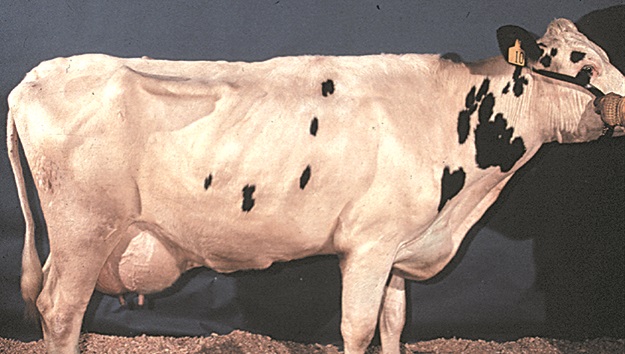
Close-ups
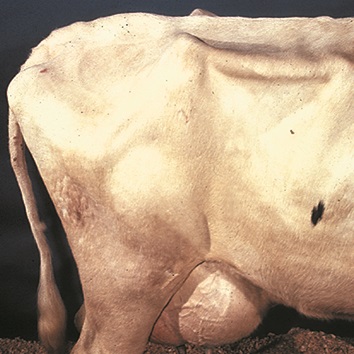
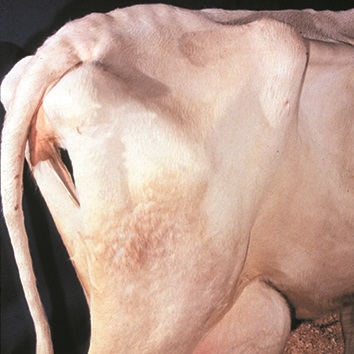

Condition score 2
This cow is thin. The ends of the short ribs can be felt but they and the individual vertebrae are less visibly prominent. The short ribs do not form as obvious an overhang or shelf effect. The hook and pin bones are prominent but the depression of the thurl region between them is less severe. The area around the anus is less sunken and the vulva less prominent.
Side view
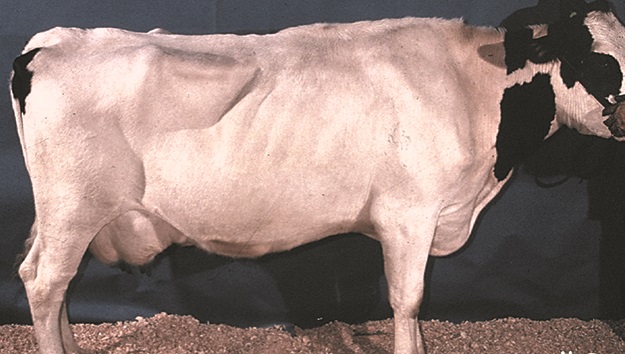
Close-ups

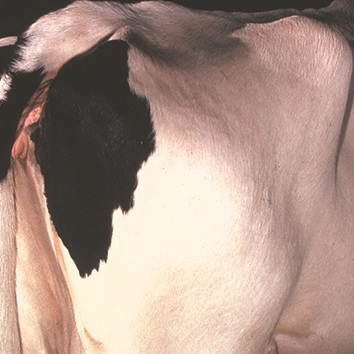
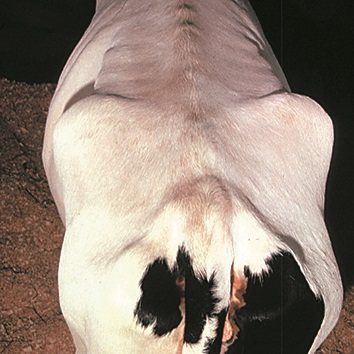
Condition score 3
A cow in average body condition. The short ribs can be felt by applying slight pressure. The overhanging shelflike appearance of these bones is gone. The backbone is a rounded ridge, and hook and pin bones are round and smoothed over. The anal area is filled out but there is no evidence of fat deposit.
Side view
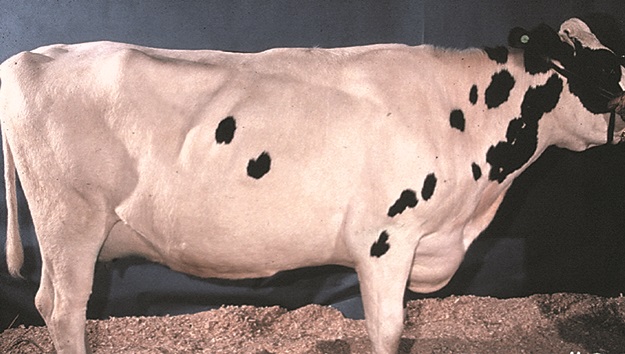
Close-ups
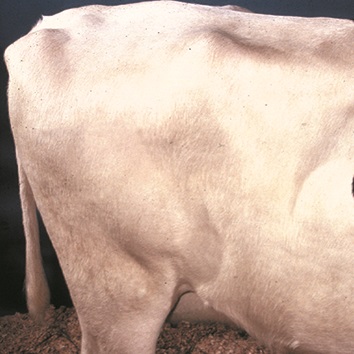
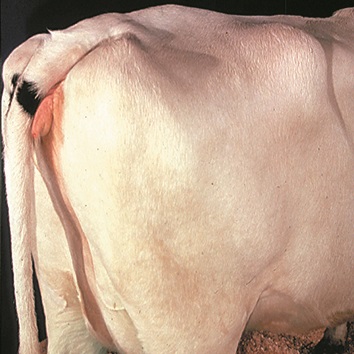
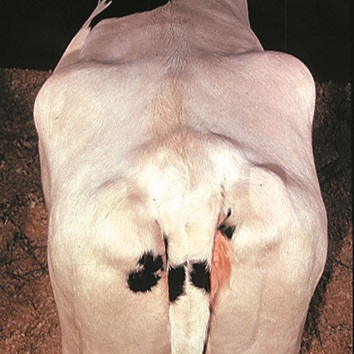
Condition score 4
A cow in heavy condition. Individual short ribs can be felt only when firm pressure is applied. Together they are rounded over with no shelf effect. The ridge of the backbone is flattening over the loin and rump areas and rounded over the chine. The hook bones are smoothed over and the span between the hook bones over the backbone is flat. Area around the pin bones is beginning to show patches of fat deposit.
Side view
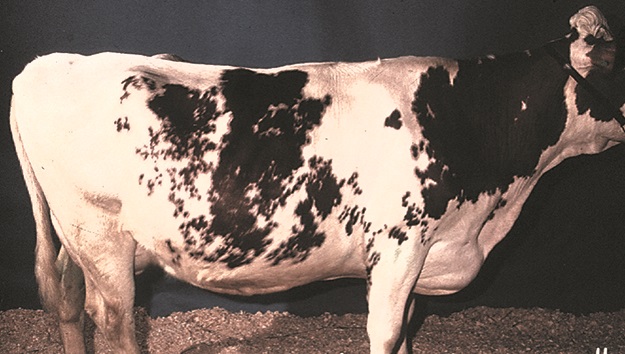
Close-ups
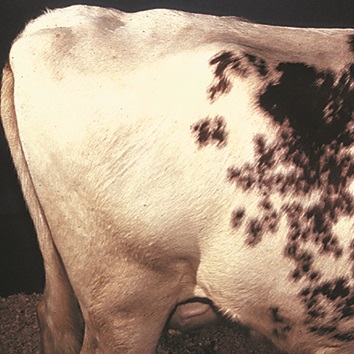
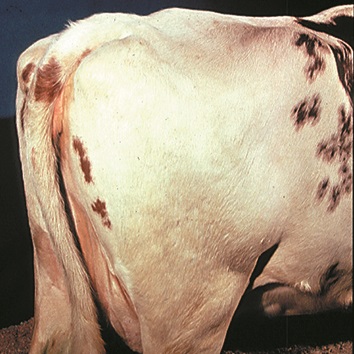

Condition score 5
A fat cow. The bone structure of the topline, hook and pin bones and the short ribs is not visible. Fat deposits around the tailbone and over the ribs are obvious. The thighs curve out, the brisket and flanks are heavy and the chine very round.
Side view

Close-ups
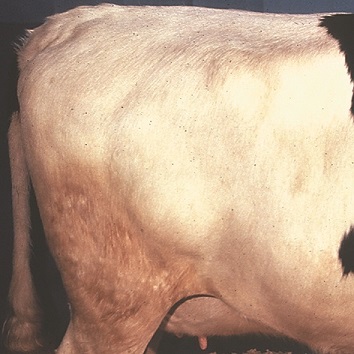
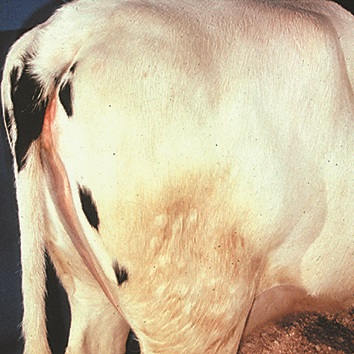

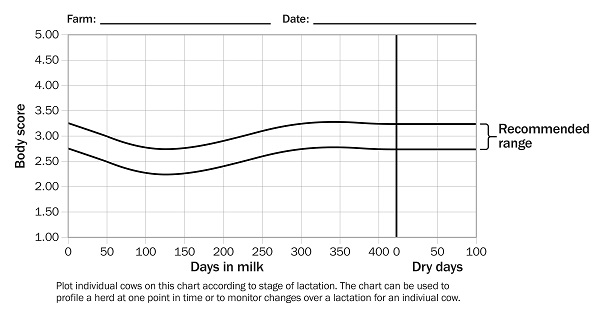
This Factsheet was updated by Mario Mongeon, Livestock Specialist, Bilingual, OMAFRA, Alfred, Tom Wright, Dairy Cattle Specialist, OMAFRA, Guelph, and Julie French, Dairy Livestock Assistant, OMAFRA, Guelph.